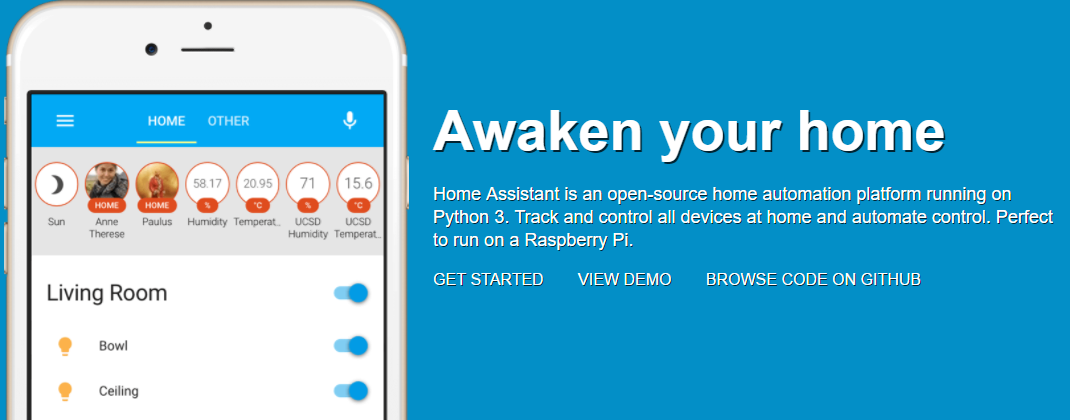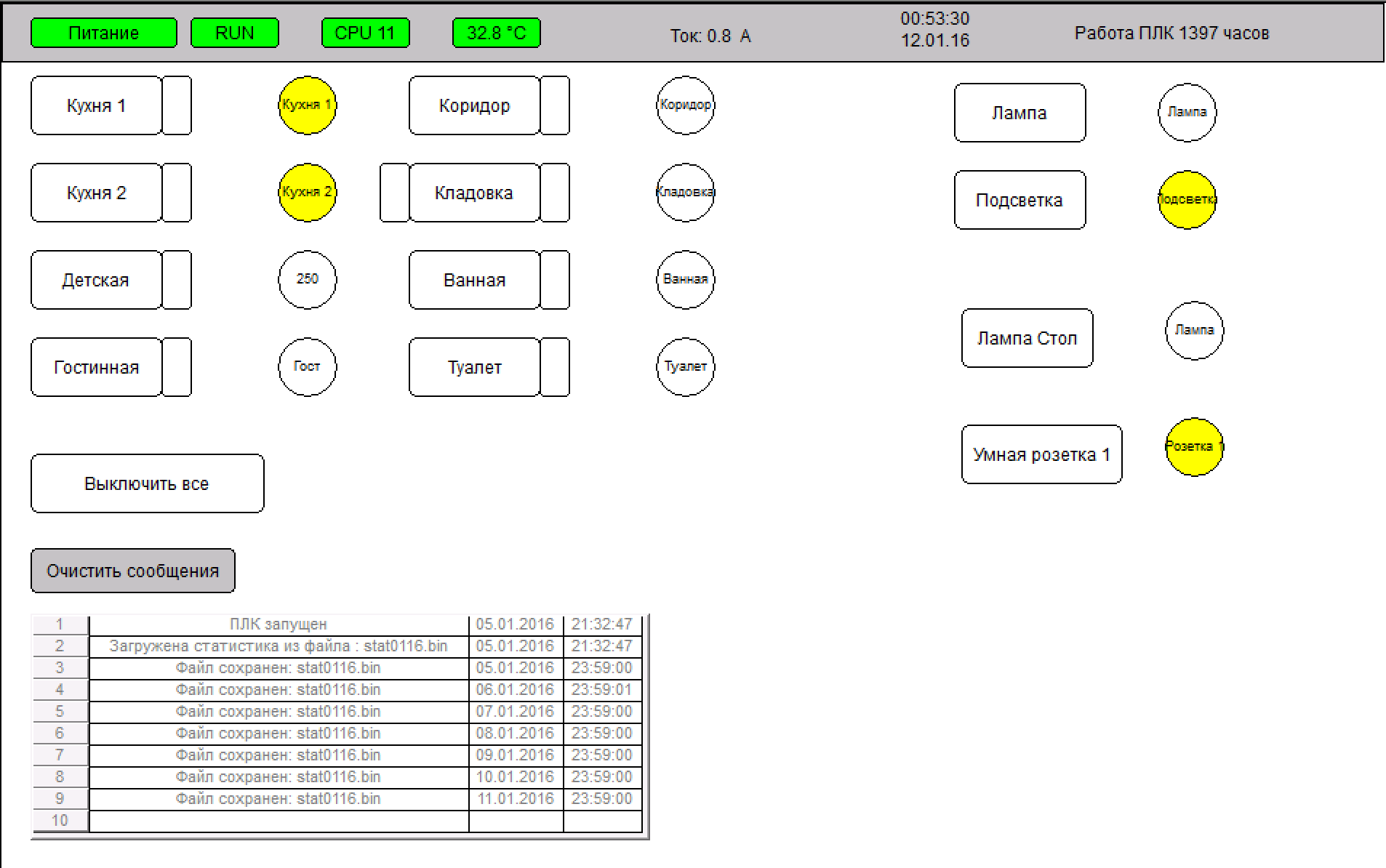How to install the smart home Home Assistant
This article is written to remind you that the smart home has become much closer than we thought.
→ View demo

')
What is a smart home can be read on Wikipedia here and here .
Let's go in order:
1. The central core
A smart home needs a central controller (hub, server, etc.). This is the link between all elements of the smart home and the user. There are distributed systems without a central controller, but you still need one information collector, which will show the user all the latest news from each device.
PC is an excellent option if you need a large load on the server, because Even old laptops' performance will be quite enough (only if you will not turn 4K video or use 10 cameras with HEVC coding). Of the minuses, in 95% of cases, active cooling and to connect a conventional relay always have to use additional crutches.
Specialized controllers are a great option if you need reliability and fault tolerance. The probability of failure of the industrial controller (with the right hands) is close to the probability of a zombie apocalypse. But there are also minus-programming and tuning can be either those who have already automated several pipelines, or a person in whose brain are not neurons but relay circuits. And most often the interface they have, to put it mildly, ascetic. Unfortunately, I'm not so smart, so this option is definitely not for me.

And here we come to the most modern version - they are cheap single-board computers based on ARM architecture. Now their choice is simply huge, but the most popular ancestor of Raspberri pi . From the advantages of low power consumption, there are user conclusions and satisfactory performance for running simple programs.
There are still many exotic options for automating your hearth, for example, an alarm clock bed at the 1851 World Fair (inventor Theophile Carter). Or a favorite perversion - Arduino with shields (forgive forgiveness for a frivolous meme)

2. External sensors, controllers, controls.
This topic is so extensive that it is not possible to describe all the variety of images in this article, therefore we will leave it for future articles. In short, there is:
- DIY solutions and arduino solutions
- Chinese solutions (example Sonoff)
- Dear beautiful solutions (example nest)
3. Software
We will also take this discussion into a separate topic. Today we will consider only one of the many open platforms. Reviews will still be. Immediately answer the questions why it is she:
a) A huge number of supported services
b) Easy and free to install,
c) Nice interface.
4. Third Party Services
They help connect different existing solutions and automate actions on smartphones and PCs. A typical example of IFTTT .
What if I can’t program or have money?
Separately, there are solutions of modern ecosystems from Samsung , Xiaomi , Amazon , Apple , Google , etc. I agree that sometimes their decisions look much more beautiful, but the average salary of a Russian person is about $ 500, which does not allow you to feel the full range of tastes.
So let's go!
Recommended for purchase:
1. Raspberry Pi 3 (older ones will probably do) $ 35
2. MicroSD on 16GB not lower than class 10 (the faster, the better) with an adapter to the computer $ 7
3. MicroUSB charger for 5V and more than 2A $ 0 (came from the old phone)
4. Your precious time. Priceless.
5. Optional HDMI monitor
Let's install:
1. Download a convenient program for writing to a USB flash drive. I recommend the portable version.
2. Go to the site and download the latest version of Hassbian
3. Unzip the main image to any folder.
4. Open Etcher
5. Choose our main image
6. Choose our flash drive for recording
7. Press the start button.
eight. ???
9. Profit
After recording, remove the flash drive and paste into pi.
IT IS NECESSARY TO INSERT THE INTERNET-CORD INTO THE MARINE !!!
When power is applied, the red light should come on and the green light will start flashing erratically. We are waiting with a cup of tea for 10 minutes.
After that we need to find the web interface of our smart home system. There are several ways to do this:
1) View our command line via hdmi and find there IP of the form 192.168.1.x (or any other)
2) look in the settings of the router which DHCP server assigned the address to the new device
3) Use a network scanner (for example, Advanced IP Scanner Portable )
After that, open the browser (not the program for downloading browsers, but the browser)
And we enter our IP +: 8123 (I have it 192.168.1.101:8123 )
And voila! Our system has booted!

Everything is well described on the official website (but in English) so if I’m interested, I can write a few examples of how to do this in real life.
I recorded all the steps on the video, so do not be shy and go to the video.
Dear readers, write in the comments, what else really want to see?
Thanks for attention!
Home Assistant is an open-source automation platform running on Python 3. Allows you to monitor and control all devices in your home and automate actions. Ideal for running on a single Raspberry PI computer.
→ View demo
')
What is a smart home can be read on Wikipedia here and here .
Let's go in order:
1. The central core
A smart home needs a central controller (hub, server, etc.). This is the link between all elements of the smart home and the user. There are distributed systems without a central controller, but you still need one information collector, which will show the user all the latest news from each device.
PC is an excellent option if you need a large load on the server, because Even old laptops' performance will be quite enough (only if you will not turn 4K video or use 10 cameras with HEVC coding). Of the minuses, in 95% of cases, active cooling and to connect a conventional relay always have to use additional crutches.
Specialized controllers are a great option if you need reliability and fault tolerance. The probability of failure of the industrial controller (with the right hands) is close to the probability of a zombie apocalypse. But there are also minus-programming and tuning can be either those who have already automated several pipelines, or a person in whose brain are not neurons but relay circuits. And most often the interface they have, to put it mildly, ascetic. Unfortunately, I'm not so smart, so this option is definitely not for me.

And here we come to the most modern version - they are cheap single-board computers based on ARM architecture. Now their choice is simply huge, but the most popular ancestor of Raspberri pi . From the advantages of low power consumption, there are user conclusions and satisfactory performance for running simple programs.
There are still many exotic options for automating your hearth, for example, an alarm clock bed at the 1851 World Fair (inventor Theophile Carter). Or a favorite perversion - Arduino with shields (forgive forgiveness for a frivolous meme)

2. External sensors, controllers, controls.
This topic is so extensive that it is not possible to describe all the variety of images in this article, therefore we will leave it for future articles. In short, there is:
- DIY solutions and arduino solutions
- Chinese solutions (example Sonoff)
- Dear beautiful solutions (example nest)
3. Software
We will also take this discussion into a separate topic. Today we will consider only one of the many open platforms. Reviews will still be. Immediately answer the questions why it is she:
a) A huge number of supported services
b) Easy and free to install,
c) Nice interface.
4. Third Party Services
They help connect different existing solutions and automate actions on smartphones and PCs. A typical example of IFTTT .
What if I can’t program or have money?
Separately, there are solutions of modern ecosystems from Samsung , Xiaomi , Amazon , Apple , Google , etc. I agree that sometimes their decisions look much more beautiful, but the average salary of a Russian person is about $ 500, which does not allow you to feel the full range of tastes.
So let's go!
Recommended for purchase:
1. Raspberry Pi 3 (older ones will probably do) $ 35
2. MicroSD on 16GB not lower than class 10 (the faster, the better) with an adapter to the computer $ 7
3. MicroUSB charger for 5V and more than 2A $ 0 (came from the old phone)
4. Your precious time. Priceless.
5. Optional HDMI monitor
Let's install:
1. Download a convenient program for writing to a USB flash drive. I recommend the portable version.
2. Go to the site and download the latest version of Hassbian
3. Unzip the main image to any folder.
4. Open Etcher
5. Choose our main image
6. Choose our flash drive for recording
7. Press the start button.
eight. ???
9. Profit
After recording, remove the flash drive and paste into pi.
IT IS NECESSARY TO INSERT THE INTERNET-CORD INTO THE MARINE !!!
When power is applied, the red light should come on and the green light will start flashing erratically. We are waiting with a cup of tea for 10 minutes.
After that we need to find the web interface of our smart home system. There are several ways to do this:
1) View our command line via hdmi and find there IP of the form 192.168.1.x (or any other)
2) look in the settings of the router which DHCP server assigned the address to the new device
3) Use a network scanner (for example, Advanced IP Scanner Portable )
After that, open the browser (not the program for downloading browsers, but the browser)
And we enter our IP +: 8123 (I have it 192.168.1.101:8123 )
And voila! Our system has booted!

Everything is well described on the official website (but in English) so if I’m interested, I can write a few examples of how to do this in real life.
I recorded all the steps on the video, so do not be shy and go to the video.
Dear readers, write in the comments, what else really want to see?
Thanks for attention!
Source: https://habr.com/ru/post/370569/
All Articles